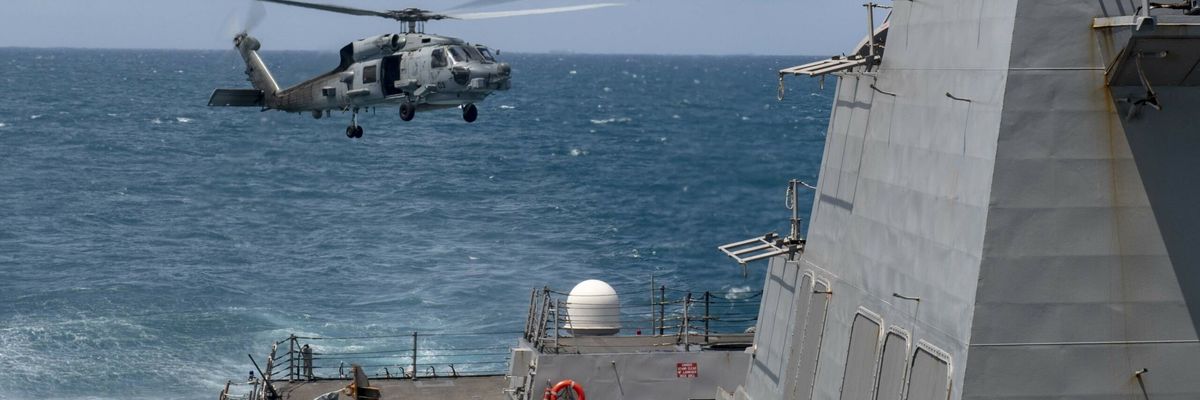In an essay just published in Foreign Affairs entitled, “Why Beijing Might Resort to Force,” China military analyst Oriana Skylar Mastro argues that Beijing has become far more inclined to use force against Taiwan, will likely strike suddenly before the U.S. can react, and will be most effectively deterred from attacking the island only under the “remote” possibility that a large international coalition can unite to counter China economically, politically, and militarily.
She sees a less effective unilateral U.S. military counter as unable to prevent a PRC missile attack on Taiwan without escalating the conflict in dangerous ways. Mastro concludes that the U.S. is only now waking up to this new reality of there being no good solutions for America’s Taiwan problem.
Mastro is correct in calling attention to the increased danger of a serious crisis or even armed conflict between the U.S. and China over Taiwan, as well as the challenges involved in preventing such outcomes. But, in keeping with a broader trend in U.S. commentary on Taiwan, the apparent assumptions, logic, and evidence she employs to make her argument about the nature of the problem and the difficulties confronting any effective policy response are in many places highly questionable, and on some points simply wrong.
To begin, Mastro incorrectly places a near sole emphasis on military calculations and Xi Jinping’s supposedly unprecedented desire to resolve the Taiwan problem in the near to medium term — along with increased public pressure — as the key determinants of China’s calculus toward Taiwan. She paints a picture of Beijing as having basically discarded the possibility of any peaceful resolution of the issue, which has now presumably become a question largely of when, not whether, it will use force, unless the U.S. can deter it through various types of threats and punishments. Indeed, in her other writings, she has argued that Beijing will attack once it feels confident that it can succeed militarily.
There is no strong, much less conclusive evidence of such a fundamental shift in Beijing’s calculus; nor of a virtually sole focus by China’s leaders on military metrics to assess how it should handle Taiwan. And there are some reasons to think the reality lies elsewhere.
First, to make her case, Mastro cites Xi Jinping’s statement about needing to resolve the issue as part of China’s overall rejuvenation. This is certainly worrying. But such signs of impatience and calls for clear progress toward unification by China’s top leader are by no means unprecedented and clear evidence of a “new” leadership viewpoint. Former Chinese president Jiang Zemin at one time extolled the idea of establishing an explicit near to medium-term timeline for unification. It is China’s growing military capabilities, not Xi Jinping’s words, that produce the greater concern by far.
Second, although many Chinese defense analysts and others with whom Mastro has discussed the issue might think that China is about to acquire the means to successfully attack Taiwan (or has already done so) and therefore will proceed accordingly, there is no indication that this view has reached some kind of clear consensus within leadership circles. The political, economic, and military disincentives and uncertainties involved in a Chinese attack on Taiwan, of whatever kind, remain extremely high. Although Mastro cites various indicators to suggest that Beijing might believe these factors aren’t very significant, scores of China analysts argue otherwise based on other evidence.
Third, while the increased PLA activities near Taiwan cited by Mastro certainly raise concerns, it is by no means clear that such activities signal an overall intent to attack the island. To the contrary, a close reading of the timing of such activities suggests that they are more logically read as deterrence signals sent in response to specific actions taken by the U.S. or Taiwan, or more broadly as indications of efforts to strengthen China’s overall defense capabilities along its maritime periphery.
In addition, Mastro never mentions that Beijing has yet to build the large numbers of amphibious landing craft needed for an invasion of Taiwan. In fact, according to annual Defense Department reports to Congress on the Chinese military, its inventory of those necessary vessels is smaller than it was a decade ago. Moreover, the PLA has allowed its inventory of short-range ballistic missiles across from Taiwan to decline by almost 50 percent in recent years.
This does not mean that Beijing is less able to apply other forms of force in a Taiwan conflict than in the past. For example, it has significantly increased its capacity to interdict U.S. forces in a variety of ways. But it does suggest that Beijing is not currently building its forces for a sudden “fait accompli” seizure of the island, as Mastro argues is most likely to occur.
The most significant problem with Mastro’s analysis is that she entirely ignores the fact that effective deterrence must rely not only on threats of punishment of various types, but also on credible assurances that one’s threatening capabilities will not be used to undermine or destroy the opponent’s most vital interests.
In the case of Taiwan, for Beijing, this vital interest involves the maintenance of the possibility of eventual unification with the mainland or, put another way, preventing the permanent separation of the island from China. This interest is closely linked to Chinese nationalism, which is in turn a major pillar of the legitimacy of the Chinese regime. Defending this interest is a war or peace issue for China.
This might be taken by some as evidence that China is easily willing to risk war to return Taiwan to China and is thus preparing to do so. But, again, this ignores the continued extreme risks and dangers involved in such an effort, including nuclear war (a prospect which Mastro does not mention). These factors mean that, for Beijing, the imperative remains to prevent permanent separation, not to complete unification.
Therefore, it is quite possible, indeed likely, that the Chinese leadership would only attempt to seize the island by force if it were to conclude that U.S. deterrence actions had become deliberately linked to a political and military effort by Washington, with Taipei’s support, to permanently detach Taiwan from the mainland.
Any effective U.S. policy designed to prevent crisis or conflict with China over Taiwan must thus include credible assurances that the increased military and intelligence capabilities advocated by Mastro and many others (this author included) will not be used in the service of a One China, One Taiwan policy. This political calculus, more than any military one, will likely prove most decisive for Beijing. But there is no discussion of such a dynamic in Mastro’s essay. She seems to assume that it doesn’t exist, or has been negated by Xi Jinping’s supposedly unprecedented thirst to seize the island.
The increasingly adversarial nature of Sino-U.S. relations and Washington’s ever-closer movement toward Taipei are pushing Beijing toward the above worst case assessment of U.S. and Taiwanese motives. Similarly, the deteriorating relationship and Chinese military moves near Taiwan are driving many in the U.S. to interpret worst case Chinese motives and intentions toward the island. This dynamic is not inevitable, however, and needs to change. But it will not do so simply on the basis of more effective punitive deterrence threats, which will only be met by yet more effective counter-threats.
Mastro is correct in concluding that there is no “quick and easy” fix to the Taiwan issue. No one thinks there is. It can only be managed for the foreseeable future through a credible mix of deterrence and reassurance measures on all sides that go beyond the mere mouthing of a continued fealty to the “one China policy” by Washington, or of a “peaceful resolution” by Beijing. We have yet to see such measures by either side, and Mastro’s analysis unfortunately does not contribute to efforts to achieve a more realistic, balanced approach.
















